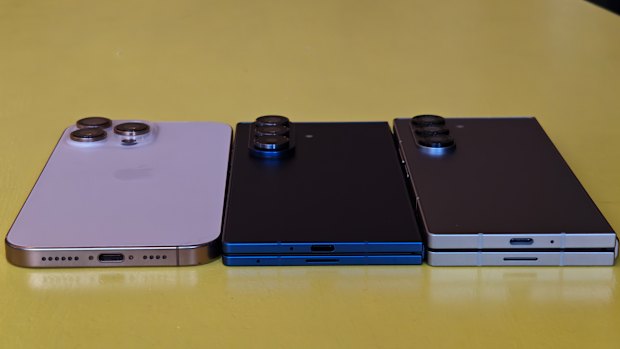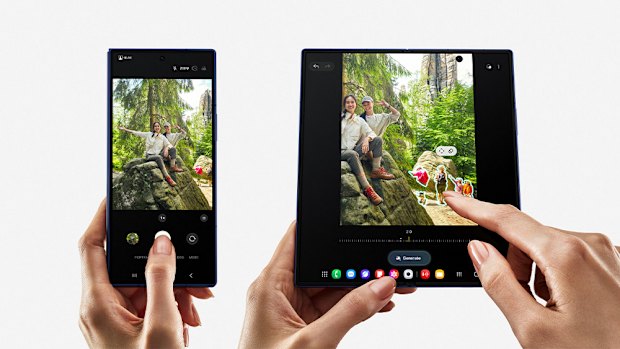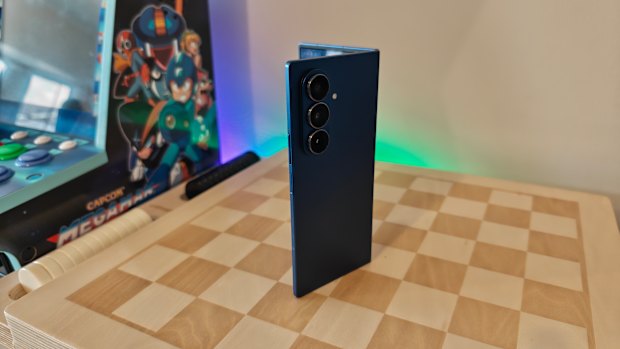- Review
- Technology
- Phones
Samsung’s big foldy phone is back with a sleek update
By Tim Biggs
There’s not a whole lot exciting about an annual phone refresh that makes the handset thinner and lighter, with better cameras and a bigger screen. In fact, that describes the majority of iterative phone upgrades over the past decade for all the major brands.
But while Samsung’s Galaxy Z Fold7 looks like a minor improvement on paper, in reality the changes have dealt with practically every issue with the big folding phone, and put it back on track as something that could conceivably become a mainstream option.
The frame has shed 1½ millimetres in thickness, which sounds like a tiny difference but means that, when it’s folded up, it’s less than 9mm thick, whereas last year’s model was more than 12mm. In fact, I’m not sure it could realistically get any thinner than this if it needs to keep the USB-C port.
The shrink makes the Fold a lot more pocketable than the chunky, 16mm-thick models of five years ago, but more importantly it makes it equivalent to (or in some cases thinner than) the size of standard phones. And it weighs 215g – lighter than many premium handsets. One notable downside of the skinniness is lower battery life than most high-end phones; you’ll be charging it every night unless you engage the battery saver.

The Fold7 is closer in thickness to the iPhone 16 Pro Max (left) than the Fold6 (right).Credit: Tim Biggs
Less (bulk) is more
The bigger screen is an important part of this upgrade, too. The cover screen has been expanded to be wider than before, so it no longer feels like a TV remote or a bookmark. It’s still skinnier than a standard phone, but you don’t get the issue where most apps are simply too cramped.
The extra bulk and a compromised cover display have been the biggest issues with all Galaxy Z Fold models since Samsung fixed the hinge in the first couple of generations. Now, the Fold feels like a regular phone when it’s closed, so you only need to unfold it when you need that tablet-style space.
When you do open it up, there’s a significantly bigger screen inside compared with last year, too; it’s now an eight-inch (20cm) OLED, and practically square. This makes multitasking much nicer, as it just feels like you have two phones side-by-side, with Samsung’s desktop-like taskbar at the bottom, rather than a pair of too-skinny windows.

A regular screen for most functions, a bigger screen for when you need to go in-depth.Credit:
None of this is to say the Z Fold is now perfect. Samsung has added a thinner, more durable hinge that it also says is longer-lasting and puts less strain on the inner screen, but I found it significantly harder to open. You need to really exert some downward pressure with your thumbs to pry the two halves apart.
Not only that, but the extreme thinness of the phone paired with big camera lenses means it has the most egregious desk wobble I’ve ever seen. I can’t believe Samsung didn’t move the cameras to be horizontally aligned so at least two corners of the phone could be near the table at the same time. This is something you could fix with a case (or a chair-leg stopper stuck to the top right of the phone’s back), but you shouldn’t have to.
Made for multitasking
If you’re still wondering whether there’s any utility to the book-style foldy phone design, I’d argue that question has been answered in the affirmative over the past half-decade; there are plenty of situations where a bunch of extra screens come in handy. A real-world example from when I was just ordering groceries: instead of moving back and forth between the supermarket’s app and your shopping list, you can just open the phone and keep them side by side. Any app that you want to watch in real time, such as Maps if you’re on a train, or Uber Eats if food is coming to you, can be easily smooshed over to one side so you can keep doing other things as well. It’s also great for binge-watching and text messaging at the same time.

When opened up, the Fold7 is an extremely skinny little tablet that feels solid to hold.Credit: Tim Biggs
Aside from multitasking, some apps get more useful on the larger screen as well. That includes anything data-heavy such as email, where you can get the list on one side and the detail on the other, or even the camera, where you don’t have to close the viewfinder to look at the snaps you just took. The set-up is also great for half-folding the phone laptop-style to prop it up for timer photos, or displaying a camera preview on the cover screen so that your subject can see themselves.
And speaking of cameras, the hardware upgrade for the Z Fold is significant this year. The main shooter is Samsung’s finest 200MP unit from its S25 Ultra phone, while the 12MP ultrawide gains autofocus to unlock macrophotography. The 3x telephoto lens and cover display selfie camera are mostly unchanged, while the internal selfie camera is now sharper and wider but sits visible within the display rather than hiding beneath it.
All up it makes for a great phone photography experience, with excellent results under all conditions from the main camera. Zoom shots can get grainy in low light, but given the tiny frame that these cameras are jammed into, that’s not a bad compromise.
The Fold7 borrows a lot more from the S25 Ultra besides the main camera; it’s powered by the same Snapdragon 8 Elite chip, brings over basically the same suite of AI features, and has the same guarantee of seven annual OS upgrades. But the new phone arrives with One UI 8, based on Android 16, which its siblings are yet to receive.
Samsung has done a good job making sure the AI experiences make sense across both displays, which wasn’t always the case in One UI 7. For example, if you summon Gemini, you can choose to have its responses in a floating window or a half-screen next to your existing app, and it all reformats smartly if you open the device while conversing with the assistant.
Get news and reviews on technology, gadgets and gaming in our Technology newsletter every Friday. Sign up here.